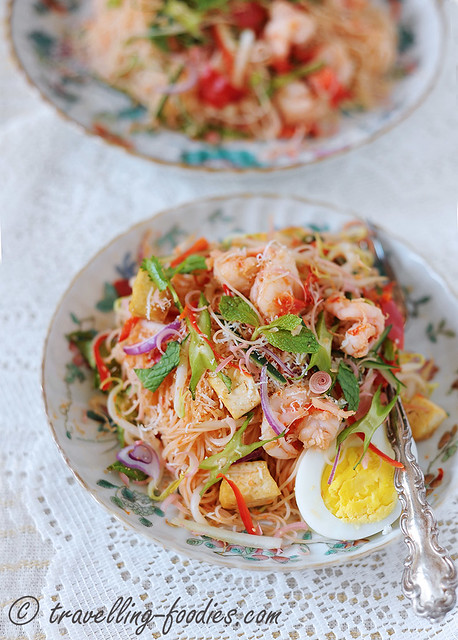On the Trail of the Phoenix – Chap Chye… A Revisit

Chap Chye is a quintessential dish for anyone who takes an interest in Peranakan food to learn to cook . It has its roots in Chinese cuisine of course but has since become deeply ingrained and naturalised into the Straits Chinese way of cooking. For us, Chap Chye is a dish which never fail to make its appearance on the dining table whenever we celebrate a major festival at my Grandma’s. Like I’d mentioned before, this dish together with kari ayam and ngoh hiang are hailed as the “holy trinity” which reminds me much of my grandma’s cooking even until today. It is her speciality, which she faithfully prepared the day before, in full knowing that the dish takes a good overnight rest for the flavours to develop and mature. Traditionally, chap chye is a must whenever there is ancestral prayers, alongside other dishes like pongteh but as the generations evolved, the rule for chap chye as a laok semayang has relaxed over time as it is now commonly enjoyed even over simple family dinners.
ผัดไทย Pad Thai and A Short Review on David Thompson’s “Thai Street Food”

One of my earliest experience with Thai food is probably Pad Thai, together with the other quintessential “must-orders” for anyone venturing into Thai cuisine, like Tom Yum Goong and Pineapple Fried Rice. Every street hawker does Pad Thai a bit differently from the other. Slight nuances in the ingredients used, the proportion of condiments, even down to the sequence of adding the ingredients, e.g. when to crack the egg etc. could alter the taste and texture of the dish completely. But they are all quite delicious. Well, most of them are at least. To date, this popular street food which brings together three important ingredients commonly used in Thai cooking, i.e. palm sugar, tamarind pulp and fish sauce, remains one of my favorites, being sweet, sour and savory all at the same time.
(more…)
Spaghetti alla Laksa Pesto

I’m usually not a big fan of fusion food. Call me archaic but I prefer to keep the flavours of the dishes I prepare “clean” and true to their roots and origins. French is kept as French as possible while Chinese remains distinctively Chinese. Save for a few exceptions in pastry making, crossovers ain’t exactly my thing. That said, the devil’s advocate in me would sprout the occasional what ifs, curious what the dish would be like when it is totally taken out of context or juxtapose with another cooking genre. And of late, these previously occasional episodes of what ifs are beginning to haunt me more frequently.
(more…)
On the Trail of the Phoenix – Sambal Jantung Pisang

Geylang Serai is a place that reminds me much of my childhood. Apart from the Orchard Road shopping belt, the stretch around City Plaza and Tanjong Katong Shopping Centre was one of the earliest built-up shopping areas in the eastern part of Singapore, more affectionately known as “Yokoso” in the past. It is also the major stronghold for the Malay community in Singapore, likening Chinatown and Little India to the Chinese and Indians respectively. Long before Geylang Serai became the infamous weekend rendevous spot for Pinoy domestic helpers and their Bangladeshi boyfriends, this place was the hub of the Malay culture and heritage in Singapore. Apart from visits during the month-long pasar malams (night markets) during the pre-Hari Raya Ramadan (fasting) period to soak in the festivities, my mother, together with her sisters visited this place frequently throughout the year to shop and makan(feast), since Orchard Road was often deemed as being too “atas” (haute couture) and out-of-place for heartlanders like us. My cousins and I would simply tag along, usually an ice-cream or a paper cone of kachang putih at hand. So “Yokoso” became the port-of-call de facto for all our shopping needs, from fabrics for making curtains and cushion covers from Joo Chiat Complex, to clothes from “2nd Chance” at Tanjong Katong Shopping Centre and not forgetting shoes and Casio watches from shops at City Plaza. And no trip to Geylang Serai is complete without a visit to its wet market and food centre, where one can sample the essence of Malay as well as Indian Muslim culinary delights, from an assortment of kuih-muihs (sweet pastries) and light snacks, to more robust Sup Kambing and Tulang Merah. The wet market section was also fantastic, where one could find a wide variety of fresh ingredients from the usual produce of fruit, fish and meat, to the more exotic, like to garner a whole entourage of herbs for Nasi Ulam.
Truth be told, I haven’t been there for eons, despite passing by the area ever so frequently. I often wonder how the place is like now, or if my favorite Indian Rojak stall was still in business. But I’d never really felt compelled to go in. Strange I know, don’t ask me why. Alas as fate has a funny way of coming around, my ventures into Peranakan cooking has brought me back here again, to buy buah keluak, or source for the freshest petai beans still in their pods. And thus when I have a craving and was looking for ingredients to make Sambal Jantung Pisang, I knew the perfect place to start hunting.
On the Trail of the Phoenix – Sambal Udang Belimbing

Peranakans love cooking with fruits, spanning from the usual tropical varieties like pineapple in Sambal Nanas to durian in Apam Balik and banana in Pengat, to using more exotic varieties in lesser prepared dishes like young jackfruit in Sayur Nangka Masak Lemak, banana blossom in Kerabu Jantung Pisang and unripe papaya in Buah Paya Masak Titek. Some fruits are used almost exclusively in culinary cuisines from this region, and buah belimbing is one such fruit.
(more…)


